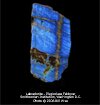 The labradorite gemstone gets its name from the region Labrador in Canada where this gem stone is found in plenty. Even before the year 1000, the natives of Maine used this gem for decoration. However, it was only in the 1770’s that the labrafdorite got its name, when it was found by Moravian Missionaries in Labrador.
The labradorite gemstone gets its name from the region Labrador in Canada where this gem stone is found in plenty. Even before the year 1000, the natives of Maine used this gem for decoration. However, it was only in the 1770’s that the labrafdorite got its name, when it was found by Moravian Missionaries in Labrador.
Labradorite occurs in large crystal masses in anorthosite rock and shows an iridescence or play of colors, like the wings of tropical butterflies. Iridescence is an optical phenomenon and is a characteristic property of surfaces in which the hue changes according to the angle from which the surface is viewed (as may be seen in butterfly wings). 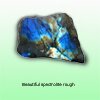
When the light hits the thin microscopic, semi-transparent layers of the labradorite gemstone, there is a phase shift. This phase shift causes numerous reflections that interfere with each other, making parallel bands of shimmering spectral color, usually blue flashes and greens flashes giving out a greenish blue hue. This phenomenon in the labradorite is named after this mineral, and is know as labradorescence.
Composition of Labradorite Gem
 A labradorite is a combination of 30 to 50% of albite and 50 to 70% of anorthite. Albite is sodium aluminum silicate (NaCa AlSi3O8) and anorthite is calcium aluminium silicate (CaAl2Si2O8). The specific gravity is usually between 2.58 and 2.70 and the refractive index ranges from 1.560 to 1.568. The hardness on Mohs scale ranges from 6 to 6.5.
A labradorite is a combination of 30 to 50% of albite and 50 to 70% of anorthite. Albite is sodium aluminum silicate (NaCa AlSi3O8) and anorthite is calcium aluminium silicate (CaAl2Si2O8). The specific gravity is usually between 2.58 and 2.70 and the refractive index ranges from 1.560 to 1.568. The hardness on Mohs scale ranges from 6 to 6.5.
 Varieties
VarietiesLabradorite belongs to the feldspar group. The multicolor variety found in Madagascar is referred to in trade circles as ‘rainbow moonstone’ (this misleading name is used to promote the gem, though it is not a moonstone).
The variety of labradorite that exhibits a high degree of iridescence, with brilliant spectral hues is called spectrolite. Heliolite is the variety mined in Oregon with a schiller effect that flashes out red, green, blue and orange. Many of these have more than one color in each stone.
Labradorite Color
 Labradorite is a dark gray colour mineral. In most cases, it displays only one or two iridescent colors and these are mostly blue and green. This gives out an amazing rich greenish blue color. The labradorite variety that shows more that two spectral colors is called Spectrolite. This variety displays a wide variety of amazing spectral colors like yellow, orange and red as well as blue and green. These color change depends upon the viewing angle.
Labradorite is a dark gray colour mineral. In most cases, it displays only one or two iridescent colors and these are mostly blue and green. This gives out an amazing rich greenish blue color. The labradorite variety that shows more that two spectral colors is called Spectrolite. This variety displays a wide variety of amazing spectral colors like yellow, orange and red as well as blue and green. These color change depends upon the viewing angle.
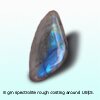 Based on the most prominent color it sometimes gets the name – examples can be a yellow labradorite, red labradorite or a golden labradorite. Transparent stones, which are available in a yellow color are very rare and are usually perceived as a collector’s item.
Based on the most prominent color it sometimes gets the name – examples can be a yellow labradorite, red labradorite or a golden labradorite. Transparent stones, which are available in a yellow color are very rare and are usually perceived as a collector’s item.
Cut
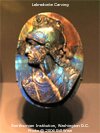 This gem is mostly cut as a cabochon cut (dome shape). Many a times the gem is custom cut as per the need of the jewelry manufacturer. These are used to make a necklace, earrings, labradorite rings, bracelets and other labradorite jewelry. Rainbow moonstone, known to have good transparency, is cut in the form of a fancy faceted gem. Labradorite beads are used to make labradorite bead necklaces.
This gem is mostly cut as a cabochon cut (dome shape). Many a times the gem is custom cut as per the need of the jewelry manufacturer. These are used to make a necklace, earrings, labradorite rings, bracelets and other labradorite jewelry. Rainbow moonstone, known to have good transparency, is cut in the form of a fancy faceted gem. Labradorite beads are used to make labradorite bead necklaces.
Carat
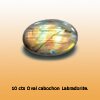 As in most cases, the availability of natural labradorite in the market is proportional to its demand. The standard prices for the semi precious varieties run in the low price per weight range, but exceptional quality stones can demand a higher market price.
As in most cases, the availability of natural labradorite in the market is proportional to its demand. The standard prices for the semi precious varieties run in the low price per weight range, but exceptional quality stones can demand a higher market price.
Clarity
The natural labradorite gem can be found in the range of transparent to opaque. A transparent gemstone is very rare though. Some gems may have black needle like inclusions, metal-like platelets of iron oxide (that may give a shinny effect) and magnetite.
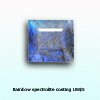 Labradorite can be found in the price range of US$ 10 per piece to US$ 1000 and more . This price range depends upon the spectral colour displayed by the stone, quality of the material and transparency of the gemstone.
Labradorite can be found in the price range of US$ 10 per piece to US$ 1000 and more . This price range depends upon the spectral colour displayed by the stone, quality of the material and transparency of the gemstone.
Andesine labradorite can be bought for US$ 10 per carat to US$ 100 per carat depending upon the transparency, richness and depth in the colour of the gemstone. Though it can cost far beyond this price range.
Besides Canada, the labradorite is also found in India, Russia, Africa, USA and Finland. Spectrolite is mainly found in India and Finland, while the rainbow moonstone is only found in Madagascar.
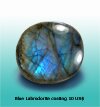 Treatments done on Labradorite Gemstone
Treatments done on Labradorite GemstoneTreatments are carried out on gemstone to lighten or darken the color or to improve the clarity and transparency and make them look polished. This is done in order to fetch a better price for the stone in the market. There are no known treatments that are being experimented on labradorite gem stone currently.
Gems like beryl, quartz, fibrolite and kyanite can be confused with many varieites of the beautiful labradorite.
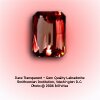
Most gemstones are used as specially-cut unique large centerpieces for designer labradorite pendants. These are generally set in a sterling silver pendant or sterling silver pendant. This gemstone is also used in carvings, decorative wooden articles and decorative wall tiles.
Andesine labradorite is the newly found variety of labradorite which is found in red to honey-red to orange, yellow, champagne and green colour. It has a a vitreous to dull luster. Andensine labrodorite was discovered in the Andes mountains in South America. Recently these gems are mined in Africa.
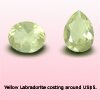 Reference
Reference1) Webster
2) Gemmology by Peter G.Read
3) Handbook of Gem Identification - Richard T.Liddicoat, jr
4) Gems and Crystals - From the American Museum of Natural History - Anna S.Sofianides and George E.Harlow.
Home | Add URL | About Us | Contact Us | Links | Privacy Policy | Resources | Sitemap | Design by Paper Tree
Copyright 2007 GehnaBazaar.com. All rights reserved. The information contained in this webpage may not be published, broadcast, rewritten or redistributed without a prior written consent. Natural Gemstones | Precious Gemstones | Jewellery Designers | Jewelry Institutes | Jewelery Design Institutes | Gemstone Information | Diamond Information | Gemmological Laboratories | Gem Labs | Jewelry Articles | Gold Price | Jewel Store | Buy and Sell Jewellery | Jewery Classes | Deisgn classes | Gemologists | Diamond Price